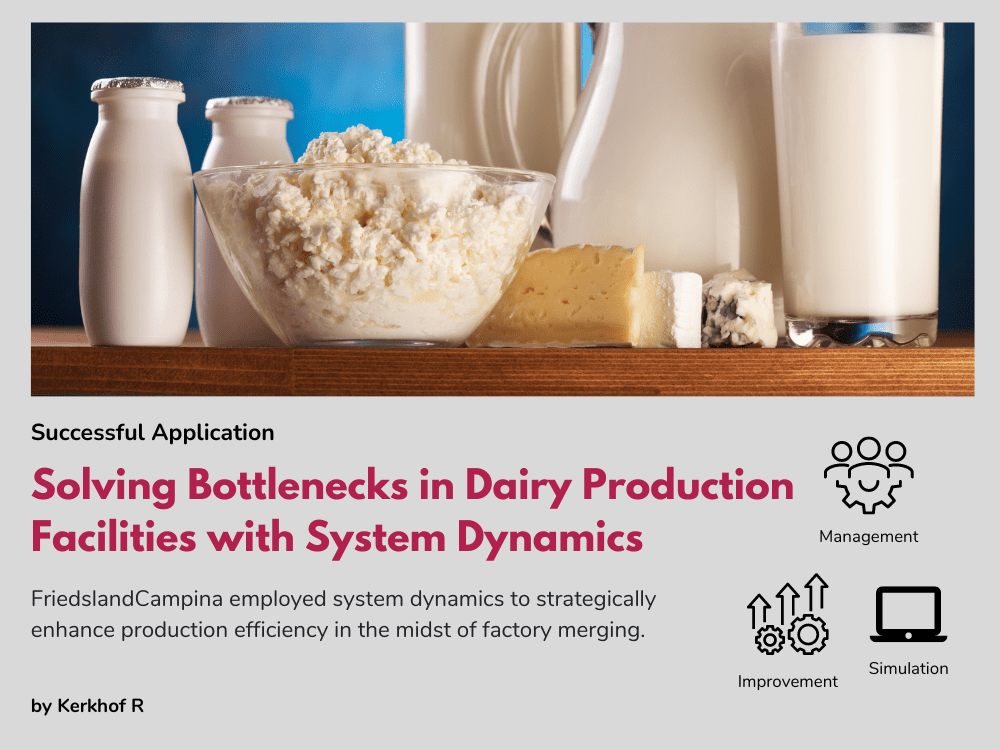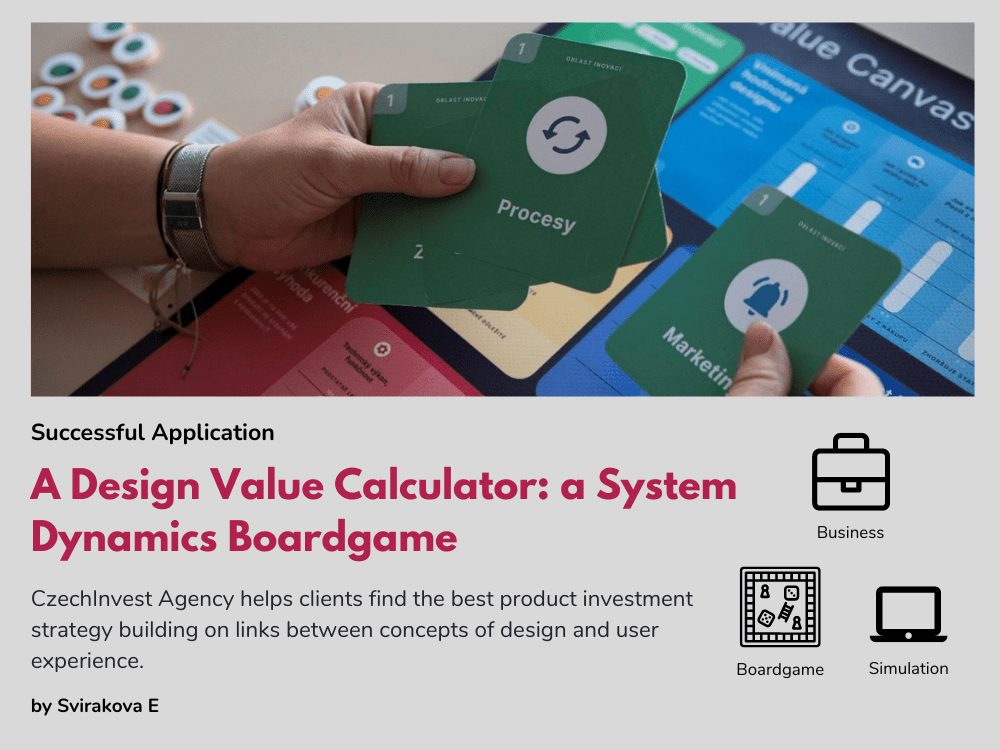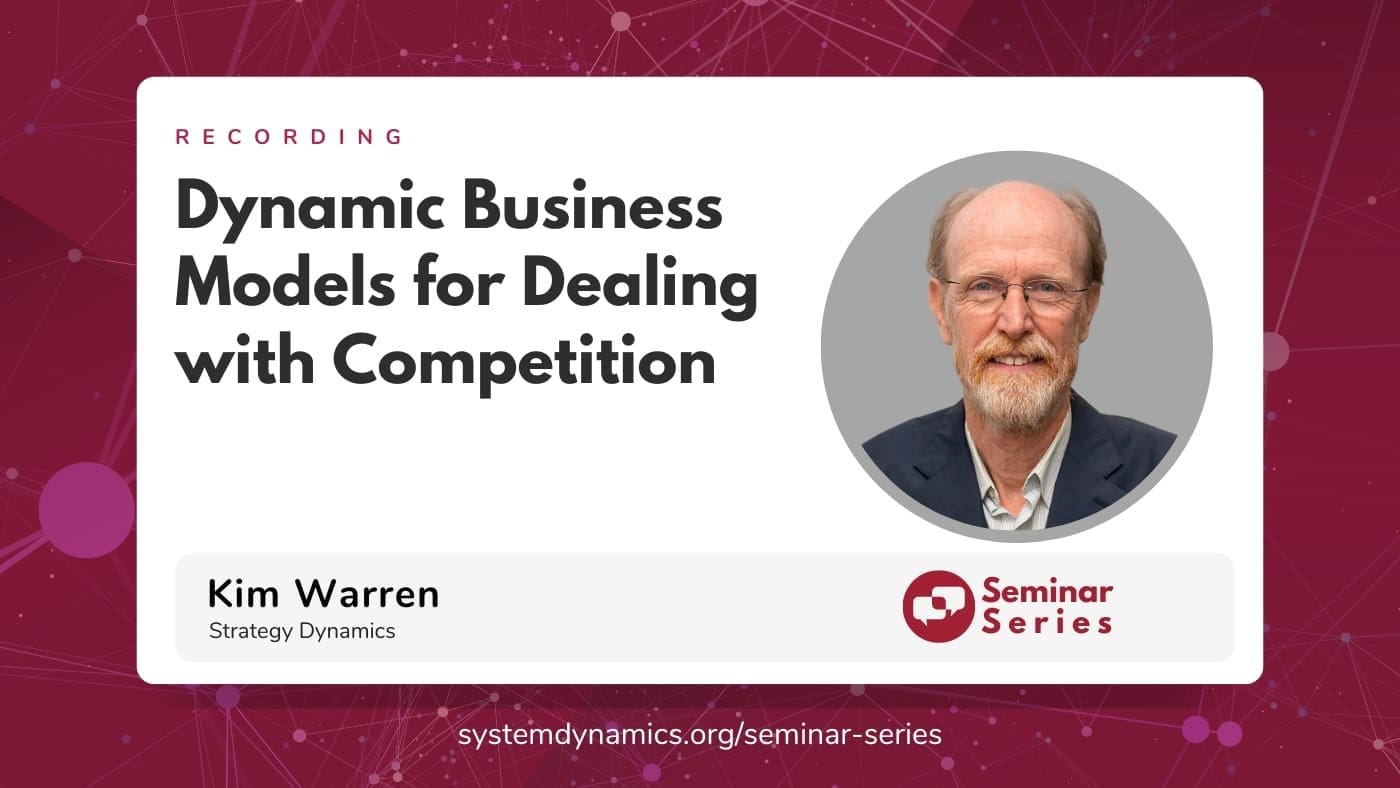Solving Bottlenecks in Dairy Production Facilities with System Dynamics
EXECUTIVE Summary
-
FrieslandCampina faced potential bottlenecks in production due to the merging of two factories. They hired SD&Co which employed system dynamics simulation models to predict and manage these issues effectively, ensuring smooth operational integration.
-
The project led to strategic changes, such as optimizing algorithms for pallet selection and adding a conveyor belt system, thereby enhancing efficiency without the need for extensive physical expansion of facilities.
-
The implemented changes have prepared FrieslandCampina to handle increased production volumes and maintain efficiency even in scenarios of partial factory downtime, demonstrating a successful adaptation to the merger’s demands.
#FriedslandCampina #SD&Co #Diary #Netherlands
The Problem
FrieslandCampina, a Dutch cooperative, specializes in transforming milk from dairy farmers into a wide array of dairy products. They were undertaking a significant project: merging two of their production facilities. This merger was anticipated to introduce new challenges, particularly in the filling and palletizing stages, as well as in the operations of their fully automated warehouse. The project was handled by SD&Co and their primary goal was to foresee potential bottlenecks under various post-merger production scenarios. Identifying these potential bottlenecks was crucial to ensure a smooth transition and maintain efficiency. Additionally, SD&Co was tasked with devising strategies to address these bottlenecks in the most effective and efficient manner possible, keeping in mind the operational workflow and the increased scale of production due to the merger.

Figure 1 – FrieslandCampina’s production facility
The Solution
FrieslandCampina faced a significant challenge: implementing changes to their factory could take up to two years. This long time frame posed a risk of reduced production output or the possibility of overinvesting in capacity expansion. The complexity of the situation was heightened by the interconnected nature of the factory and warehouse processes, which made it challenging to accurately predict outcomes using traditional tools like spreadsheets.
To navigate these complexities, SD&Co employed a comprehensive approach by developing four distinct simulation models. Each model varied in scope and level of detail, enabling a thorough analysis of a wide range of production scenarios and potential physical modifications to both the factory and the warehouse. These simulations were instrumental in testing the effects of various changes and understanding their impact on the overall operations.
Thanks to these sophisticated simulation models, FrieslandCampina and its suppliers were able to pinpoint the most effective and efficient solutions. They could identify adjustments to the factory and warehouse that would best accommodate the increased volumes resulting from the merger of the factories. This strategic approach allowed for a well-informed decision-making process, ensuring that the adjustments made were optimally aligned with the new operational requirements.
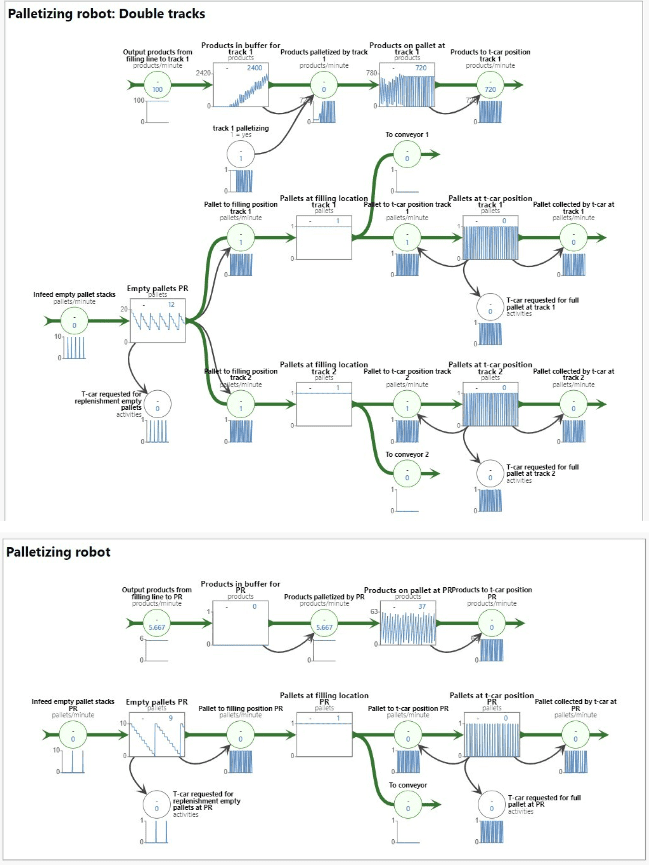
Figure 2 – Examples of sectors of the system dynamics model developed by SD&Co.
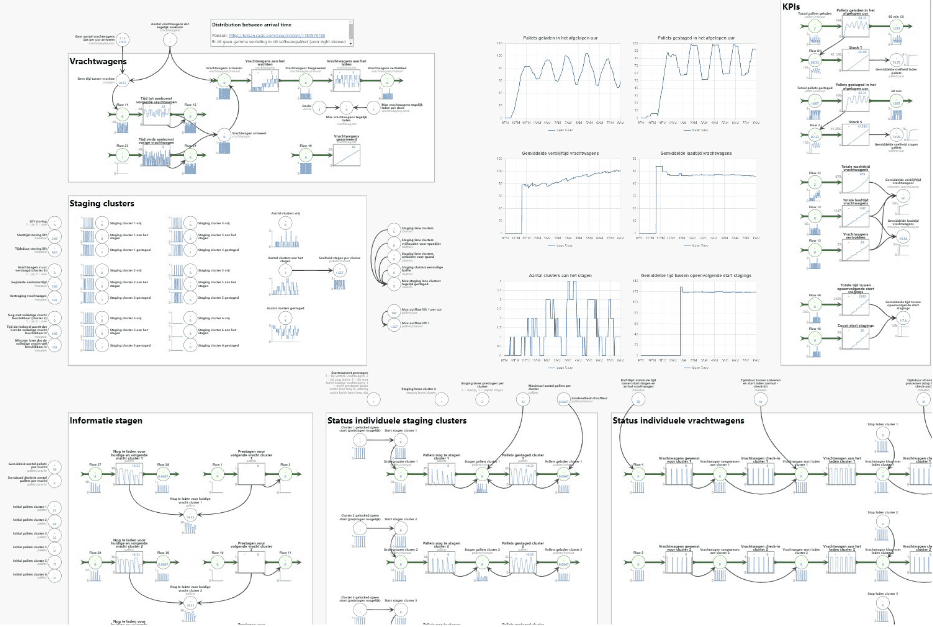
Figure 3 – Overview of simulation dashboards.
Outcomes
In this pivotal project, SD&Co identified the most efficient modifications necessary for the factory and warehouse to handle the increased volumes post-merger. FrieslandCampina, in collaboration with its suppliers, is actively implementing these recommended changes. The key deliverables of this project were the innovative simulation models and a comprehensive presentation detailing the recommended changes. These system dynamics tools provided valuable insights, leading to strategic adjustments within the operational framework of FrieslandCampina.
One significant change was the refinement of the algorithm that manages the selection of pallets for outbound elevators. This adjustment negated the need for physical expansion of the outbound elevators and staging lanes, thereby optimizing existing resources.
Additionally, they introduced a small conveyor belt behind two palletizers to avoid the need for a more extensive and costly redesign of the internal transport system around the palletizers.
Based on the simulation, FrieslandCampina also made a strategic decision to refrain from further investments. The model demonstrated that the new capacity would be adequate across a variety of production scenarios. This included scenarios where parts of the factory might temporarily break down or require maintenance. The project’s outcomes have significantly contributed to the robustness and efficiency of FrieslandCampina’s operations. The implemented changes ensured that the factory and warehouse can smoothly handle increased volumes, while providing a buffer for unforeseen production challenges.
Do you want to know more?
Connect with Roland van de Kerkhof.
OTHER SUCCESSFUL APPLICATIONS
A Design Value Calculator: A System Dynamics Boardgame
CzechInvest Agency helps clients find the best product investment strategy building on links between concepts of design and user experience.
The World Bank Uses System Dynamics to Identify Root Causes of Poverty
Investigating Madagascar’s complex poverty issues to empower communities with tailored anti-poverty strategies.
Fast-Track Cities Uses System Dynamics to Enhance HIV Care
Portuguese Oncology Institute Enhances Patient Care and Resource Management for an Oncology Intensive Care Unit diminishing mortality and turnover rates.
Upcoming Events

IN-PERSON | Student-Organized Colloquium 2024
Open to all! Bringing together students and practitioners from different industries to share ideas, and develop modeling skills
Recent Posts
Honoring Excellence: A Glimpse into the Awards of the International System Dynamics Conference
Dive into the prestigious awards and honorable mentions of the International System Dynamics Conference, celebrating trailblazers and emerging talents in the field
From Bergen to Global: UiB’s System Dynamics Group
Discover the rich history and innovations of the System Dynamics Group at the University of Bergen, a European epicenter for dynamic systems research, education, and global collaboration
Consideo’s Insight into the Global Energy Transition: A Systems Perspective
Consideo’s deep dive into global energy transition strategies, electrification, and renewables for a sustainable future
Join us
OTHER SUCCESSFUL APPLICATIONS
A Design Value Calculator: A System Dynamics Boardgame
CzechInvest Agency helps clients find the best product investment strategy building on links between concepts of design and user experience.
The World Bank Uses System Dynamics to Identify Root Causes of Poverty
Investigating Madagascar’s complex poverty issues to empower communities with tailored anti-poverty strategies.
Fast-Track Cities Uses System Dynamics to Enhance HIV Care
Portuguese Oncology Institute Enhances Patient Care and Resource Management for an Oncology Intensive Care Unit diminishing mortality and turnover rates.
Recent Posts
Honoring Excellence: A Glimpse into the Awards of the International System Dynamics Conference
Dive into the prestigious awards and honorable mentions of the International System Dynamics Conference, celebrating trailblazers and emerging talents in the field
From Bergen to Global: UiB’s System Dynamics Group
Discover the rich history and innovations of the System Dynamics Group at the University of Bergen, a European epicenter for dynamic systems research, education, and global collaboration
Consideo’s Insight into the Global Energy Transition: A Systems Perspective
Consideo’s deep dive into global energy transition strategies, electrification, and renewables for a sustainable future
Upcoming Events

IN-PERSON | Student-Organized Colloquium 2024
Open to all! Bringing together students and practitioners from different industries to share ideas, and develop modeling skills
Leveraging Dynamic Business Models for Enterprise Architecture
In the session Leveraging Dynamic Business Models for Enterprise Architecture, part of the System Dynamics for Business Innovation series led by Kim Warren, the conversation centered on enriching Enterprise Architectures (EAs) through the integration of quantitative Dynamic Business Models (DBMs). This approach significantly amplifies the efficacy and reliability of IT strategies and planning.
Course
Dynamic Business Modelling
How to build powerful living models of plans or issues in half the time of using spreadsheets
Key Insights:
- Foundation of Enterprise Architectures (EAs):
- EAs provide a structural blueprint for IT strategy development, focusing on the organization’s processes and how these support its operational goals.
- The webinar highlighted the importance of understanding these frameworks for implementing effective IT systems aligned with business objectives.
- Role of Dynamic Business Models (DBMs):
- DBMs contribute to a more robust EA by introducing quantitative analyses that validate and enhance the traditionally qualitative aspects of EA.
- By modeling business dynamics quantitatively, DBMs facilitate more accurate IT system alignment with strategic business goals, improving resource allocation and change management.
- Synergies between EAs and DBMs:
- The webinar illustrated how DBMs strengthen EAs by providing a rigorous analytical foundation that accelerates and refines the architecture building process.
- These models help predict the impact of IT strategies on business performance, making implementation more effective.
- Applications and Validation:
- DBMs offer a structured approach to testing and validating IT strategies before full-scale implementation, ensuring that IT plans are both effective and aligned with overarching business strategies.
- The session underscored the utility of DBMs in real-world applications, demonstrating their capacity to support complex decision-making across diverse business domains.
- Impact on IT Strategy and System Planning:
- Incorporating DBMs into EA efforts leads to more informed decision-making, with enhanced insights into the interactions between various business functions and IT systems.
- This integrated approach supports a proactive stance in IT strategy formulation, emphasizing continuous adaptation and alignment with business changes.
The webinar was particularly relevant for IT professionals, systems architects, business analysts, and strategic managers. It also offered critical insights for academics and students in business and technology disciplines.
Watch the recording below
Whoops, this recording is available for members and ticket purchasers only. Please login to verify. If you’re not a member, purchase a membership here. You can also buy a ticket to watch the recording here.
About the Speaker
Kim Warren is an experienced strategy professional, teacher, and publisher of online courses and teaching resources on business modeling – fast becoming a mainstream capability for executives, consultants, and business students. He was awarded the Jay Wright Forrester Award by the International System Dynamics Society in 2005 and was the Society’s President in 2013.
Recent Posts
From Bergen to Global: UiB’s System Dynamics Group
Discover the rich history and innovations of the System Dynamics Group at the University of Bergen, a European epicenter for dynamic systems research, education, and global collaboration
Consideo’s Insight into the Global Energy Transition: A Systems Perspective
Consideo’s deep dive into global energy transition strategies, electrification, and renewables for a sustainable future
A Digital Twin Business Model in 40 Hours
Facing an escalating support-ticket crisis in a fast-growing B2B SAAS platform, we built a ‘digital twin’ business model to map out challenges, drive sustainable growth, and avert potential business disasters
Upcoming Events

IN-PERSON | Student-Organized Colloquium 2024
Open to all! Bringing together students and practitioners from different industries to share ideas, and develop modeling skills
Recent Business cases
A Design Value Calculator: A System Dynamics Boardgame
CzechInvest Agency helps clients find the best product investment strategy building on links between concepts of design and user experience.
The World Bank Uses System Dynamics to Identify Root Causes of Poverty
Investigating Madagascar’s complex poverty issues to empower communities with tailored anti-poverty strategies.
Fast-Track Cities Uses System Dynamics to Enhance HIV Care
Portuguese Oncology Institute Enhances Patient Care and Resource Management for an Oncology Intensive Care Unit diminishing mortality and turnover rates.
Join us
Cancer Prevention and Control with System Dynamics
The webinar titled “Cancer Prevention and Control with System Dynamics” presented a systematic review focused on the use of System Dynamics modeling in the field of cancer research. The main objective was to evaluate how this methodology is applied across various studies to address complex issues in cancer prevention and control, including treatments, risk assessments, and intervention strategies.
System Dynamics Modeling for Cancer Prevention and Control: A Systematic Review
Key insights from the webinar included:
- Application of System Dynamics: The review detailed how both simulation models and causal-loop diagrams are utilized to study the dynamics of cancer-related issues, ranging from chemotherapy effectiveness to the impacts of environmental contaminants on cancer risks.
- Quality Assessment: The studies were assessed for quality based on criteria like clarity of objectives, adequacy of information sources, and the involvement of stakeholders. This highlighted a need for more rigorous standards in modeling to enhance reliability and applicability.
- Focus Areas and Interventions: The research covered diverse topics such as the effectiveness of cancer treatments, prevention through behavioral changes, and early detection techniques. It also underscored the importance of System Dynamics in modeling interventions like tobacco use reduction and vaccination strategies.
- Recommendations for Improvement: The presentation stressed the necessity for greater transparency and rigor in System Dynamics studies within cancer research. It called for the development of supportive infrastructures and best practices to foster multidisciplinary collaborations.
The presenters, Erin Kenzie and Wayne Wakeland, through their extensive backgrounds in systems science and health policy, emphasized the potential of System Dynamics to offer comprehensive insights and effective solutions in cancer prevention and control.
For those interested in exploring innovative methodologies and their practical applications in addressing complex health issues, watching the recording of this webinar is highly recommended. It promises valuable learnings in System Dynamics and its significant role in advancing cancer research.
Watch the recording below
Whoops, this recording is available for members and ticket purchasers only. Please login to verify. If you’re not a member, purchase a membership here. You can also buy a ticket to watch the recording here.
PRESENTERS
Erin Kenzie is an Assistant Professor at the OHSU-PSU School of Public Health at Oregon Health and Science University in Portland, Oregon and holds faculty roles at the Portland State University System Science Program and the Oregon Rural Practice-based Research Network. She received her PhD in Systems Science from PSU in 2021. Dr. Kenzie’s research spans system dynamics, implementation science, and public health. She has been involved in research applying System Dynamics to colorectal cancer screening, behavioral health system capacity, unhealthy alcohol use screening and treatment, rural Veteran access to care, health plan-clinic partnerships, behavioral health integration, traumatic brain injury recovery, and climate change mitigation behavior.
Wayne Wakeland is Professor Emeritus of Systems Science at Portland State University. He also served as the Systems Science Program Chair for many years. He earned a B.S. and a Master of Engineering at Harvey Mudd College (1973); and a Ph.D. in Systems Science at Portland State U. (1977). He developed and taught courses on computer simulation methods and more recently a course on system sustainability and organizational resilience. His research focused on the use of computational models for studying a variety of topics, including complications during human pregnancy, recovery from concussion, and policies to reduce opioid drug diversion, abuse, and overdose deaths. Other topics included environmental/ecological sustainability and elevated intracranial pressure due to traumatic brain injusy. He has been active in the System Dynamics Society for many years and helps lead its Health Policy Special Interest Group.
Recent Posts
From Bergen to Global: UiB’s System Dynamics Group
Discover the rich history and innovations of the System Dynamics Group at the University of Bergen, a European epicenter for dynamic systems research, education, and global collaboration
Consideo’s Insight into the Global Energy Transition: A Systems Perspective
Consideo’s deep dive into global energy transition strategies, electrification, and renewables for a sustainable future
A Digital Twin Business Model in 40 Hours
Facing an escalating support-ticket crisis in a fast-growing B2B SAAS platform, we built a ‘digital twin’ business model to map out challenges, drive sustainable growth, and avert potential business disasters
Upcoming Events

IN-PERSON | Student-Organized Colloquium 2024
Open to all! Bringing together students and practitioners from different industries to share ideas, and develop modeling skills
Recent Business cases
A Design Value Calculator: A System Dynamics Boardgame
CzechInvest Agency helps clients find the best product investment strategy building on links between concepts of design and user experience.
The World Bank Uses System Dynamics to Identify Root Causes of Poverty
Investigating Madagascar’s complex poverty issues to empower communities with tailored anti-poverty strategies.
Fast-Track Cities Uses System Dynamics to Enhance HIV Care
Portuguese Oncology Institute Enhances Patient Care and Resource Management for an Oncology Intensive Care Unit diminishing mortality and turnover rates.
Join us
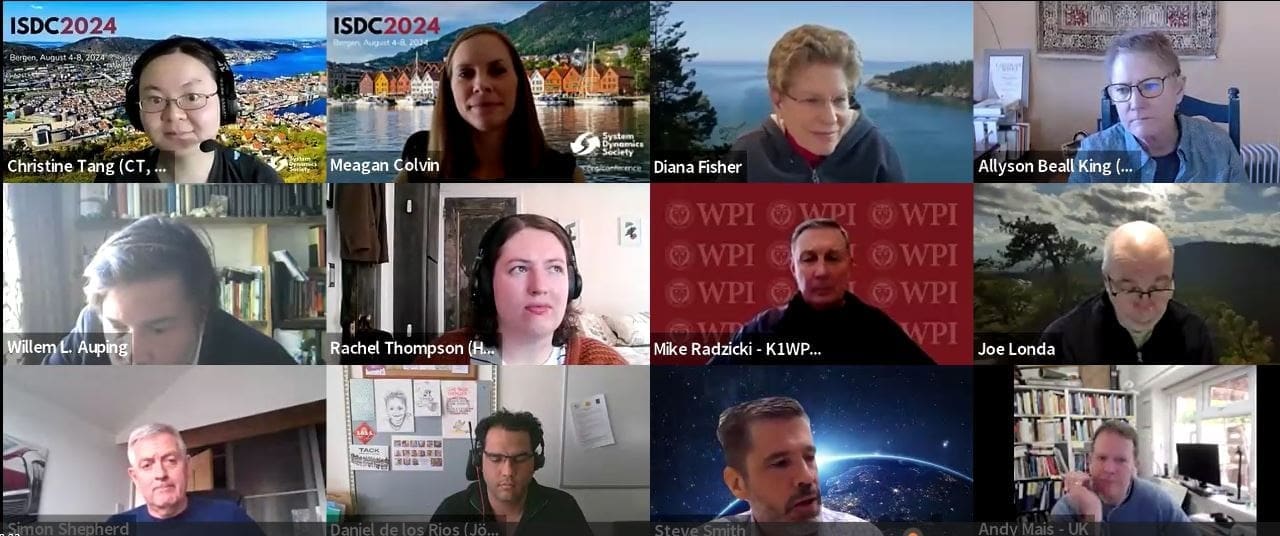
Member Orientation
The System Dynamics Society has recently hosted a New Member Orientation aimed at introducing new participants in the community. The session, led by SDS President, Allyson Beall King, and Director of Outreach, Meagan Colvin, provided an overview of the Society’s structure, mission, and opportunities for member involvement. The agenda included an introduction to the Society’s objectives, its staff, and the myriad of resources it offers.
Highlights from the Orientation
Introduction to Staff and Structure: The session provided detailed information on the organizational structure of the Society, introducing key personnel and their roles within the Society, from various locations around the globe.
Member Resources and Benefits: The orientation highlighted several benefits for members, such as:
- Discount on conference registration fee
- Free access to all seminars and recordings
- Reduced prices and some free courses for online learning.
- Free access to the System Dynamics Review.
- Membership in various Special Interest Groups (SIG) and Chapters with networking opportunities.
Interactive Sessions: The event included a question-and-answer segment where participants engaged directly with leaders, enhancing the interactive nature of the orientation.
Networking Opportunities: There was a special segment for networking, where Chapter and SIG leaders introduced themselves and shared insights into their activities, promoting community interaction among members.
The New Member Orientation underscored the System Dynamics Society’s commitment to providing valuable resources and fostering a collaborative environment. It emphasized the Society’s dedication to tackling significant global issues through System Dynamics.
For those interested in a deeper understanding of the membership benefits and to hear firsthand from Society leaders, we encourage watching the recording of the event. This will provide prospective and current members with a comprehensive view of the opportunities available within the System Dynamics Society.
Watch the recording below
Recent Posts
From Bergen to Global: UiB’s System Dynamics Group
Discover the rich history and innovations of the System Dynamics Group at the University of Bergen, a European epicenter for dynamic systems research, education, and global collaboration
Consideo’s Insight into the Global Energy Transition: A Systems Perspective
Consideo’s deep dive into global energy transition strategies, electrification, and renewables for a sustainable future
A Digital Twin Business Model in 40 Hours
Facing an escalating support-ticket crisis in a fast-growing B2B SAAS platform, we built a ‘digital twin’ business model to map out challenges, drive sustainable growth, and avert potential business disasters
Upcoming Events

IN-PERSON | Student-Organized Colloquium 2024
Open to all! Bringing together students and practitioners from different industries to share ideas, and develop modeling skills
Recent Business cases
A Design Value Calculator: A System Dynamics Boardgame
CzechInvest Agency helps clients find the best product investment strategy building on links between concepts of design and user experience.
The World Bank Uses System Dynamics to Identify Root Causes of Poverty
Investigating Madagascar’s complex poverty issues to empower communities with tailored anti-poverty strategies.
Fast-Track Cities Uses System Dynamics to Enhance HIV Care
Portuguese Oncology Institute Enhances Patient Care and Resource Management for an Oncology Intensive Care Unit diminishing mortality and turnover rates.
Join us
A Design Value Calculator: A System Dynamics Boardgame
EXECUTIVE Summary
-
Product design is a specific form of complex innovation that touches all areas of an organization’s management. While entrepreneurs recognise the value of design, they often tend to focus on areas that customers recognise as important but that they are often already happy with. Helping entrepreneurs to systemically assess the benefits of spending on developing different aspects of the user experience is, hence, fundamental to increase the return over investment and to improve business sustainability.
-
To address this, the CzechInvest Agency developed an interactive board game powered by a System Dynamics model simulator that simulates the economic development of a company over six years and calculates the profitability of changes made to the product design.
-
Based on the game results, the Agency presents opportunities to improve product design. The company’s management can thus objectively identify weaknesses and chooses a strategy to design a better product that improves profits.
#CzechInvest #ProductDesign #Innovation #CzechRepublic
The Problem
Entrepreneurs face a multitude of challenges when it comes to product design, ranging from understanding user needs to navigating technical constraints. One of the primary hurdles is identifying and addressing the true pain points of their target audience. Without a deep understanding of user behavior, preferences, and expectations, entrepreneurs risk developing products that fail to resonate with their intended market.
Additionally, entrepreneurs often fail to understand the concept of product design focusing too much on a particular aspect of their product (often the way it looks) neglecting other aspects of it. While the product presentation is important it is only one part of product design and entrepreneurs need to have a holistic view of the product balancing user-centric design with technical feasibility and cost considerations. In short, entrepreneurs need to ensure that their product ideas are not only desirable but also manufacturable and economically feasible.
The Solution
The solution developed consists of a board game and a complementary System Dynamics model. The game covers five areas of innovation that players can decide to invest on, and the simulation model is used to estimate the performance of these investments. The five areas of innovation players can select by placing a card on the boardgame are: i) services (Služby) ii) Marketing methods, iii) Customer Relationships (Vztahy se zákazníky), iv) Goods and products (Zboží), and v) Internal Company Processes (Procesy).
Once the player has selected an area, the performance of the players decision is estimated using a System Dynamics model designed for this purpose. The figure shows an overview of the building blocks of the System Dynamics model and their links. A customer segment is a group of people or organizations that a company wants to attract and create value for through an appropriate value proposition. The larger the customer segment, the more customer relationships to manage and the busier the distribution channels. Every sale means billing, and billing is a source of revenue. Higher revenue means higher PROFIT for the company, thus growing key resources, one of which is the bank account. The more money in the bank account, the better it is to buy assets, hire new employees, increase product production capacity, and expand the distribution network.
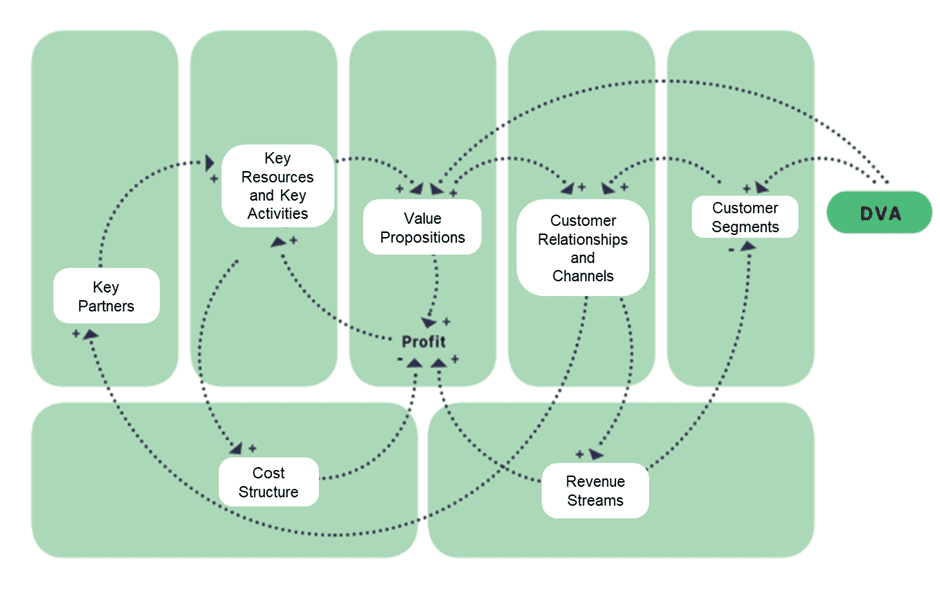
The Design Value Algorithm (DVA) coefficient enters the model in the Customer Segment building block (see figure of the Stock and Flow diagram) and thus influences all other elements in the model. The input of the DVA coefficient to the Customer Segment can also be verified in the Business Algorithms in the Dynamic Business Model illustration.
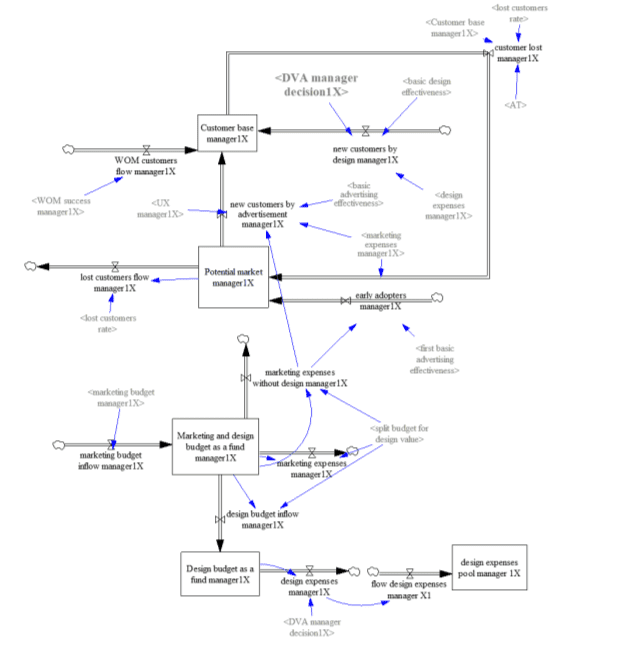
The winner of the game can be determined either:
a) by the evolution of PROFIT’s cumulative profit with other players.
b) by looking at the impact of the design improvements made during the game.
Outcomes
CzechInvest clients implemented this solution and offers structured interviews to company management. The game demonstrates a systemic link between the concepts of design and user experience and quickly reveals the best strategy for further investment in product design.
Below there are some examples and comments from one of the customers that played the game:
Client Number 1X – XYZ Ltd: “The measured value of design is the difference between the evolution of the PROFIT indicator that the company generates without investing in design (the blue curve in the graph) and the evolution of the profit that the company generates based on the decision to invest in design (the other three curves). The value of design is a dynamic indicator that changes over time.”

Interpretation for the client 1X – XYZ Ltd: “The company needs to invest in design; in this situation, where its average UX is 66%, it is profitable. “
According to the parameters given: the average UX (User Experience) = 0.66. This means that the company can still increase user experience by 34%. However, the manager did not make a strategic decision to earn more on design. Instead, he chose a strategy that is not in line with the company’s potential to increase UX. He placed investments in improving the functionality of the product first and investments in distribution third. In doing so, he identified the lowest UX sub-value in sales. If he wants to serve his customers better, he needs to strategically address sales first.
Do you want to know more?
Visit the Design Value Calculator or connect with Eva Svirakova.
OTHER SUCCESSFUL APPLICATIONS
A Design Value Calculator: A System Dynamics Boardgame
CzechInvest Agency helps clients find the best product investment strategy building on links between concepts of design and user experience.
The World Bank Uses System Dynamics to Identify Root Causes of Poverty
Investigating Madagascar’s complex poverty issues to empower communities with tailored anti-poverty strategies.
Fast-Track Cities Uses System Dynamics to Enhance HIV Care
Portuguese Oncology Institute Enhances Patient Care and Resource Management for an Oncology Intensive Care Unit diminishing mortality and turnover rates.
Upcoming Events

IN-PERSON | Student-Organized Colloquium 2024
Open to all! Bringing together students and practitioners from different industries to share ideas, and develop modeling skills
Recent Posts
Honoring Excellence: A Glimpse into the Awards of the International System Dynamics Conference
Dive into the prestigious awards and honorable mentions of the International System Dynamics Conference, celebrating trailblazers and emerging talents in the field
From Bergen to Global: UiB’s System Dynamics Group
Discover the rich history and innovations of the System Dynamics Group at the University of Bergen, a European epicenter for dynamic systems research, education, and global collaboration
Consideo’s Insight into the Global Energy Transition: A Systems Perspective
Consideo’s deep dive into global energy transition strategies, electrification, and renewables for a sustainable future
Join us
OTHER SUCCESSFUL APPLICATIONS
A Design Value Calculator: A System Dynamics Boardgame
CzechInvest Agency helps clients find the best product investment strategy building on links between concepts of design and user experience.
The World Bank Uses System Dynamics to Identify Root Causes of Poverty
Investigating Madagascar’s complex poverty issues to empower communities with tailored anti-poverty strategies.
Fast-Track Cities Uses System Dynamics to Enhance HIV Care
Portuguese Oncology Institute Enhances Patient Care and Resource Management for an Oncology Intensive Care Unit diminishing mortality and turnover rates.
Recent Posts
Honoring Excellence: A Glimpse into the Awards of the International System Dynamics Conference
Dive into the prestigious awards and honorable mentions of the International System Dynamics Conference, celebrating trailblazers and emerging talents in the field
From Bergen to Global: UiB’s System Dynamics Group
Discover the rich history and innovations of the System Dynamics Group at the University of Bergen, a European epicenter for dynamic systems research, education, and global collaboration
Consideo’s Insight into the Global Energy Transition: A Systems Perspective
Consideo’s deep dive into global energy transition strategies, electrification, and renewables for a sustainable future
Upcoming Events

IN-PERSON | Student-Organized Colloquium 2024
Open to all! Bringing together students and practitioners from different industries to share ideas, and develop modeling skills
Dynamic Business Models for Dealing with Competition
In the latest webinar of the System Dynamics for Business Innovation special series, Kim Warren delved into Dynamic Business Models for Dealing with Competition. This session, rich in practical advice and strategic insights, is pivotal for professionals seeking to sharpen their competitive edge. Here’s a breakdown of the webinar’s key points.
Key Takeaways from the Webinar:
- Understanding Competitive Dynamics: The session focused on the use of dynamic business models to navigate competitive business environments. Warren highlighted the importance of understanding how competition plays out in real-time and the impacts on prices, marketing spending, and profits.
- Case Studies and Applications: Warren used two illustrative case studies to demonstrate the practical application of these models. He discussed GSK’s travel vaccines business and its response to a new competitor, and Beyond Meat’s strategy in creating a market for non-meat products. Both cases highlighted the strategic challenges and responses in dynamic competitive environments.
- Types of Competition: Warren outlined three standard competition mechanisms, covering most competitive scenarios. These include racing to capture new potential customers, maintaining existing customers while attracting competitors’ customers, and handling situations where customers can switch between suppliers.
- Practical Strategy Development: The session also touched upon practical aspects of strategic planning, like leveraging dynamic models for both long-term strategy and short-term operational decision-making.
Invitation for Further Learning
This webinar is a must-watch for those interested in refining their competitive strategies and understanding the application of dynamic business models. Viewing the recording will provide a deeper insight into the discussed concepts.
Furthermore, the series will continue to offer rich content on strategic business areas such as IT systems architecture and environmental impact reporting. These upcoming sessions represent a unique opportunity to gain advanced knowledge and skills in the field.
Join us for the upcoming webinars to deepen your understanding of dynamic business models and their critical role in shaping successful competitive strategies
Certificate
Attendees who participate in at least 6 out of the 9 webinars in the series will be eligible to receive a certificate titled “Introduction to Dynamic Business Models.” This is an opportunity to gain recognition of your learning in this innovative field. For those who cannot attend live sessions, recordings will be available, allowing you to review the material and complete the series at your convenience.
Watch the recording to get your certificate code.
Watch the recording below
Whoops, this recording is available for members and ticket purchasers only. Please login to verify. If you’re not a member, purchase a membership here. You can also buy a ticket to watch the recording here.
About the Speaker
Kim Warren is an experienced strategy professional, teacher, and publisher of online courses and teaching resources on business modeling – fast becoming a mainstream capability for executives, consultants, and business students. He was awarded the Jay Wright Forrester Award by the International System Dynamics Society in 2005 and was the Society’s President in 2013.
Recent Posts
From Bergen to Global: UiB’s System Dynamics Group
Discover the rich history and innovations of the System Dynamics Group at the University of Bergen, a European epicenter for dynamic systems research, education, and global collaboration
Consideo’s Insight into the Global Energy Transition: A Systems Perspective
Consideo’s deep dive into global energy transition strategies, electrification, and renewables for a sustainable future
A Digital Twin Business Model in 40 Hours
Facing an escalating support-ticket crisis in a fast-growing B2B SAAS platform, we built a ‘digital twin’ business model to map out challenges, drive sustainable growth, and avert potential business disasters
Upcoming Events

IN-PERSON | Student-Organized Colloquium 2024
Open to all! Bringing together students and practitioners from different industries to share ideas, and develop modeling skills
Recent Business cases
A Design Value Calculator: A System Dynamics Boardgame
CzechInvest Agency helps clients find the best product investment strategy building on links between concepts of design and user experience.
The World Bank Uses System Dynamics to Identify Root Causes of Poverty
Investigating Madagascar’s complex poverty issues to empower communities with tailored anti-poverty strategies.
Fast-Track Cities Uses System Dynamics to Enhance HIV Care
Portuguese Oncology Institute Enhances Patient Care and Resource Management for an Oncology Intensive Care Unit diminishing mortality and turnover rates.

